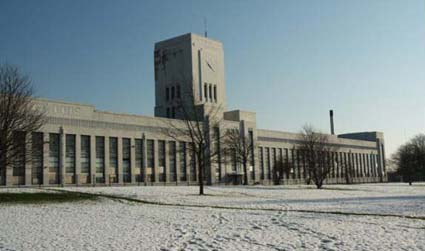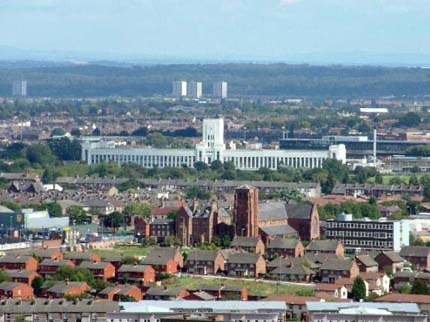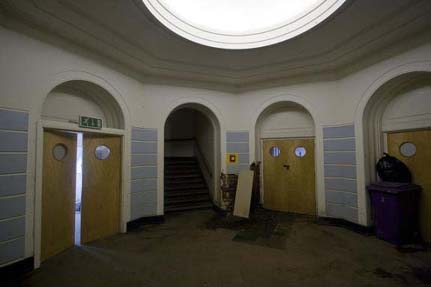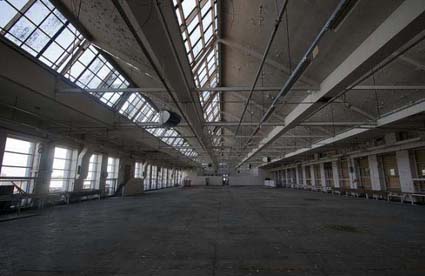Game over or Extra Time? Liverpool Art Deco Gem Faces Demolition
18.5.12
As Liverpool fans digest removal of their revered ‘King’, Kenny Dalglish, the city faces loss of another beloved icon of the beautiful game, the majestic Art Deco headquarters of the once mighty Littlewoods Football Pools.
The imposing 1930s building sits on one of Liverpool’s highest points, and dominates the main Edge Lane approach to the city centre. Its tall central clock tower and streamlined white concrete profile are visible across the eastern suburbs, and the bright stucco concrete was described as ‘outdazzling’ contemporary industrial buildings in Pevsner’s architectural guides. It is associated with one of Britain’s most famous philanthropic families, the Moores brothers, who built Littlewoods into the country’s biggest family owned firm, and at various points controlled both Merseyside football clubs, sponsoring the League Cup as well as bestowing a university and the ‘Oscar’ of the painting world, the John Moores art prize.
Yet English Heritage have refused to list the landmark and now the government’s Homes and Communities Agency (HCA), who owns the building, is reported to be considering demolition.
SAVE president Marcus Binney criticised the absentee role of national regeneration agencies, accusing them of indifference to the building’s clear architectural and historic resonance.
‘The Littlewoods Pools building is of obvious national interest through association with Britain’s biggest family firm and their philanthropic legacy, as well as being an architecturally impressive industrial landmark in the same vein as the celebrated factories on the Great West Road in London.
Government agencies need to show Liverpool’s commercial heritage its proper respect, and we call on Eric Pickles to insist his HCA civil servants guarantee this majestic building’s future.’
Littlewoods once employed thousands of mainly female workers on the vast shop floors, printing and checking the pools coupons delivered by an army of agents to every street in the country. At a time when gambling was virtually outlawed outside racecourses, ‘winning the pools’ was the weekly dream for millions of workers. The BBC’s five o’clock Saturday results programme became a weekly communion, as fervently noted as a Royal wedding or Churchill speech. Those who hit the jackpot could join the lucky band of winners elected to near Hollywood status.
Unfortunately, the building’s recent history has been far from lucky.
Liverpool’s once dominant football pools companies, which also included the smaller Vernons and Zetters, were killed off by introduction of the National Lottery in 1993. Littlewood’s shopping empire has been broken up, although it retains an online presence.
The empty building was bought a decade ago by the North West Regional Development Agency (RDA), who worked with developer Urban Splash on advanced designs for a high end hotel until the credit crunch. A proposed education campus was scrapped when Education Minister Michael Gove cancelled the Building Schools for the Future programme, and now the site has been caught up in the much criticised ‘fire sale’ of public assets following abolition of the RDAs.
Liverpool planner Jonathan Brown said the threat appeared embarrassing for the government’s ideology of localism.
‘Just a month after the regional regeneration body was wound up and its assets reverted to Whitehall control, we hear demolition of Liverpool’s supreme 20th-century industrial landmark is imminent.
That would be disastrous for the new quango’s reputation in the North West, where the Homes and Communities Agency is already under question for championing housing clearances across inner city Liverpool. We think the city’s new Mayor Joe Anderson will relish this challenge to reclaim local control and resist removal of such a classic 20th-century landmark.’
Notes to Editors:
The Littlewoods Building was completed in 1938, probably by Scottish Architect Gerald de Courcey Fraser, who also designed a number of fine department stores for Lewis’s and others.
The South Lancashire ‘Pevsner’ guide describes it as being ‘in the same vein as the celebrated factories on the Great West Road in London... outdazzling any of the buildings put up on the contemporary industrial estates’.
Sir John Moores, and his brother Cecil, built Littlewoods into the country’s largest family owned business empire, covering department chain stores and catalogue shopping, bequeathing a dynasty estimated at over £1bn.
From working class Salford stock, the Moores family were renowned as generous benefactors associated with famous local and national causes.
Liverpool John Moores University was renamed in his honour, and the Moores family controlled both Everton and Liverpool Football clubs during their 1970 and 80s glory years – Littlewoods actually sponsored the League cup for several years between 1986 and 1990.
The John Moores painting prize is described as ‘the Oscar of the British painting world’ by Royal Academy curator sir Norman Rosenthal, and famously brought David Hockney to the world’s attention in the 1960s.
The Littlewoods building’s vast, well lit internal spaces were enlisted in the national interest during WWII.
At the outbreak of the war the building’s mighty printing presses were used to print 17 million National Registration forms in just three days.
The floors of Halifax Bombers were assembled at the building, and it was also the nerve centre of MC5, the government agency that intercepted mail to break enemy codes.
Bomb shelters in the basement areas still contain artwork and graffiti on the walls dating from the 1941 Wartime Blitz and ‘Battle of the Atlantic’, when parts of Liverpool, its rail yards and docklands suffered more bombs per square mile than even London’s East End.
SAVE Britain’s Heritage has been campaigning for historic buildings since its formation in 1975 by a group of architects, journalists and planners. It is a strong, independent voice in conservation, free to respond rapidly to emergencies and to speak out loud for the historic built environment. It has published a Buildings at Risk Register for England and Wales since 1989.
For more information and images contact: Jonathan Brown or Marcus Binney




